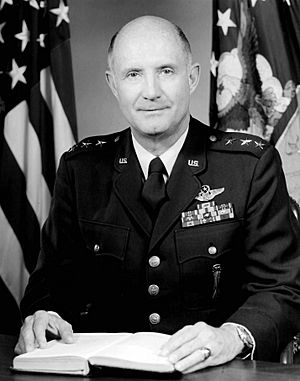Thomas P. Stafford facts for kids
Quick facts for kids
Thomas Stafford
|
|
|---|---|
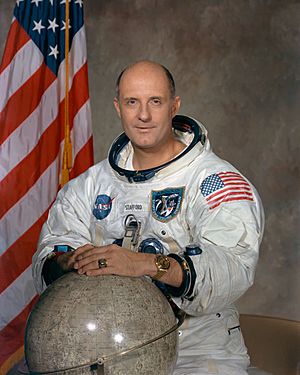
Stafford in 1972
|
|
| Born |
Thomas Patten Stafford
September 17, 1930 Weatherford, Oklahoma, U.S.
|
| Died | March 18, 2024 (aged 93) Satellite Beach, Florida, U.S.
|
| Awards |
|
| Space career | |
| NASA astronaut | |
| Rank | Lieutenant General, USAF |
|
Time in space
|
21d 3h 42m |
| Selection | NASA Group 2 (1962) |
| Missions |
|
|
Mission insignia
|
|
| Retirement | November 1, 1979 |
Thomas Patten Stafford (September 17, 1930 – March 18, 2024) was an American Air Force officer, a test pilot, and a NASA astronaut. He was one of 24 astronauts who flew to the Moon. He also led the Astronaut Office from 1969 to 1971.
After finishing at the United States Naval Academy, Stafford joined the Air Force. He flew F-86 Sabre jets before becoming a test pilot. A test pilot flies new aircraft to see how they perform. In 1962, he was chosen to be an astronaut. He flew on the Gemini 6A mission in 1965 and Gemini 9A in 1966. In 1969, Stafford commanded Apollo 10. This was the second mission with a crew to orbit the Moon. On this flight, he and Gene Cernan were the first to fly an Apollo Lunar Module very close to the Moon's surface. They got as close as nine miles!
In 1975, Stafford commanded the Apollo-Soyuz Test Project (ASTP). This was the first time the U.S. and the Soviet Union (now Russia) worked together in space. He was a brigadier general at the time. This made him the first general officer to fly in space. He met up with other spacecraft six times in space. He spent a total of 507 hours flying in space.
Stafford flew over 120 different types of airplanes and helicopters. He also flew three types of spacecraft. He was the last surviving crew member from Gemini 6A, Gemini 9A, and Apollo 10. This was after his crewmates Wally Schirra, Eugene Cernan, and John Young passed away.
In 1993, the Stafford Air & Space Museum opened in his hometown of Weatherford, Oklahoma. It started small but is now very large. The museum is connected with the Smithsonian Institution. It is the only museum with both a U.S. F-1 engine and a Soviet NK-33 engine. These engines were tested for the Space Race. The museum also has the Gemini 6 spacecraft. This is the spacecraft that Schirra and Stafford flew in when they met up with Gemini 7 in space.
Contents
Early Life and Education
Thomas Patten Stafford was born on September 17, 1930. His hometown was Weatherford, Oklahoma. His father, Thomas Sabert Stafford, was a dentist. His mother, Mary Ellen Stafford, was a teacher. His father passed away in 1948.
Stafford became interested in flying when World War II started. There was an Army Air Corps training base nearby. He began building model airplanes. He had his first flight in a Piper Cub when he was 14. He went to Weatherford High School and finished in 1948.
In high school, Stafford was offered a scholarship to play football at the University of Oklahoma. He also applied to the United States Naval Academy. He was accepted into the Class of 1952. He planned to play football for the Navy team. However, he hurt his knee before the season started. This injury ended his football career.
After his first year, he sailed on the battleship USS Missouri. His roommate was John Young, who would later be his pilot on Apollo 10. After his second year, Stafford spent a summer at NAS Pensacola. There, he learned about naval aviation and flew in a SNJ Trainer. He started dating Faye Shoemaker, who would become his first wife.
In 1952, Stafford was chosen to join the United States Air Force after graduation. He graduated from the Naval Academy with honors. He earned a Bachelor of Science degree. He then became a second lieutenant in the Air Force.
Military Service and Test Pilot Training
Stafford began his pilot training at different Air Force bases. He flew the T-6 Texan and the T-33 Shooting Star. During one training flight, he was in a mid-air crash with another student pilot. Stafford and his instructor landed safely, but the other pilot died.
He finished pilot training in 1953. He then trained to fly the F-86 Sabre jet. In 1954, Stafford was sent to Ellsworth AFB in South Dakota. He flew F-86 missions to protect the Arctic. In 1955, he moved to Ramstein AB in West Germany. He continued flying F-86 jets. He also became interested in applying for the USAF Experimental Flight Test Pilot School.
In 1958, Stafford attended the Air Force Test Pilot School at Edwards AFB in California. He was the top student in his class. After graduating, he stayed at Edwards AFB as a flight instructor. He helped create the first civilian instructor job at the school. He also helped write important handbooks for flight testing. In 1962, he was accepted to Harvard Business School. But just three days after arriving, he was accepted into NASA Group Two.
NASA Career
In April 1962, Stafford applied to become an astronaut. He went through many interviews and medical tests. On September 14, 1962, Stafford was chosen for Astronaut Group 2. Eight other future astronauts were also selected.
Project Gemini Missions
Gemini 6A: Space Rendezvous
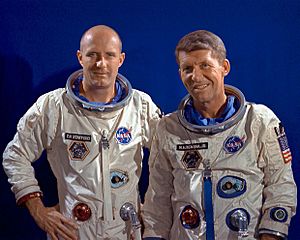
Stafford was first supposed to fly on the first Gemini mission, Gemini 3, with Alan Shepard. But Shepard was removed from the flight due to an illness. Stafford was then paired with Wally Schirra. They became the backup crew for Gemini 3 and the main crew for Gemini 6.
The original Gemini 6 plan was to connect with another spacecraft called an Agena. On October 25, 1965, the Agena rocket exploded during launch. So, the mission was changed to Gemini 6A. The new plan was to meet up with the Gemini 7 spacecraft, which was already in orbit. Gemini 7 launched on December 4, 1965.
On December 12, 1965, Gemini 6A's engines started but then immediately shut down. Stafford and Schirra stayed calm and did not eject. They found out it was an electrical problem and a cap left on a fuel line.
On December 15, 1965, Gemini 6A successfully launched. It met up with Gemini 7 in space. The two spacecraft flew very close to each other for about five hours. They were only a few feet apart! Gemini 6A landed in the ocean on December 16. It was picked up by the ship USS Wasp.
Gemini 9A: Overcoming Challenges
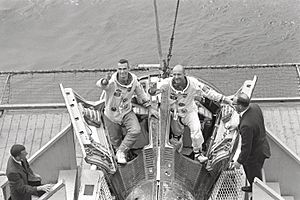
Before Gemini 6A, Stafford was assigned as the backup commander for Gemini 9. Eugene Cernan was his backup pilot. The main crew was Charlie Bassett and Elliot See. On February 28, 1966, both crews were flying in T-38 Talons to visit a spacecraft factory. Bassett and See crashed and died. Stafford and Cernan then became the main crew for Gemini 9A.
On May 17, 1966, the Agena target vehicle for their mission went off course. It was shut down before reaching orbit. A new target, the Augmented Target Docking Adapter (ATDA), was launched on June 1, 1966. The Gemini 9A launch was delayed due to a computer error.
Gemini 9A launched on June 3. It met up with the ATDA on its second orbit. However, a cover on the ATDA had only partly opened. This meant Gemini 9A could not connect with it. Still, Stafford and Cernan practiced maneuvers with the ATDA. They even simulated rescuing a lunar module in a lower orbit.
The next day, Cernan tried to go on a spacewalk (EVA). He wanted to test a special Astronaut Maneuvering Unit (AMU). But Cernan quickly had trouble moving. He also had problems with his suit's air and communication. The spacewalk was stopped. Cernan returned to the capsule after two hours. On June 6, Gemini 9A landed and was recovered by USS Wasp.
Apollo Program Missions
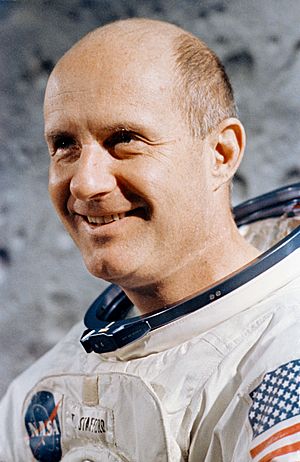
After Gemini 9A, Stafford became the backup pilot for Apollo 2. He worked on developing the Apollo guidance and navigation systems. He also worked on the command and service modules. Later, he became the backup commander for Apollo 10. His crewmates were John Young and Gene Cernan. While testing the command module, they heard about the Apollo 1 fire. This caused the Apollo program to be paused.
Apollo 10: Reaching the Moon's Orbit
In 1968, it was announced that Stafford's backup crew would be the main crew for Apollo 10. Stafford helped design a color camera for the mission. He wanted to show the public clear images from space. The command module was called "Charlie Brown." The lunar module (LM) was called "Snoopy."
Apollo 10 launched on May 18, 1969. The rocket shook a lot during launch, but Apollo 10 reached orbit safely. The LM and CM connected. Then, they fired their engines to head towards the Moon. Once in lunar orbit, Stafford and Cernan undocked in the LM. They flew in an oval-shaped orbit. At its closest point, they were only nine miles above the Moon's surface. This close pass was over the Sea of Tranquility. This was the planned landing site for Apollo 11.
As they flew back up, the LM started spinning fast. This was due to a switch that was in the wrong position. Stafford quickly got control back. They fired the engine to meet up with the CM. The LM connected with the CM, and the astronauts returned. The LM was then released. After two days orbiting the Moon, Apollo 10 began its journey back to Earth. On the way back, the capsule reached a speed of 24,791 miles per hour. This set a record for the fastest speed ever traveled by a human. Apollo 10 landed in the ocean east of Samoa. It was picked up by USS Princeton.
Apollo-Soyuz Test Project: A Historic Handshake
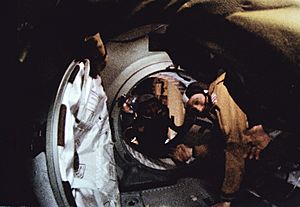
In July 1969, Stafford became the Chief of the Astronaut Office. He helped assign astronauts to upcoming Apollo and Skylab missions. During this time, U.S. President Richard Nixon and Soviet Premier Alexei Kosygin agreed to the Apollo-Soyuz Test Project (ASTP). Stafford was promoted to brigadier general in 1972. He was then named the commander of ASTP. His crewmates were Deke Slayton and Vance Brand.
Starting in 1973, the ASTP team trained a lot in both Russia and the United States. The Soviet spacecraft, Soyuz 19, launched on July 15, 1975. It carried Alexei Leonov and Valery Kubasov. Apollo launched later that day. After two days in space, Soyuz and Apollo connected on July 17. The crews met and did experiments together. They also held press conferences.
The two spacecraft stayed connected for 44 hours. They undocked on July 19. Soyuz returned to Earth on July 21. Apollo stayed in orbit until July 24. As the Apollo command module came down, it started filling with a harmful gas called nitrogen tetroxide. The crew put on oxygen masks. But Brand passed out and Stafford had to help him. All crew members were safely picked up by USS New Orleans. They were taken to a hospital in Hawaii. They had swelling from breathing in the fuel.
Post-NASA Career
In 1975, Stafford was offered command of the Air Force Flight Test Center at Edwards AFB. He accepted and started this job on November 15, 1975. Stafford was in charge of both Air Force and NASA test facilities. He continued to fly many different aircraft. He even flew foreign planes like the MiG-17.
Stafford also managed the development of a secret aircraft called the XST. This aircraft later became the F-117 Nighthawk stealth fighter. In 1978, he was promoted to lieutenant general. He became Deputy Chief of Staff for Research Development and Acquisition in Washington, D.C.. In this role, Stafford supported the creation of the mobile MX missile. He also started developing the Advanced Technology Bomber. This was the aircraft that came before the B-2 stealth bomber.
He pushed for and started a larger attack stealth aircraft. This was later called the F-117A. The F-117A flew just two years and eight months after the contract was signed. This was a very fast development time. The aircraft was ready for use in less than five years. During the Desert Storm war in 1991, it was the only plane that could fly safely over Baghdad on the first night of fighting. The F-117A flew less than two percent of the air-to-ground missions. But it attacked 38 percent of Iraq's important targets.
In 1979, Stafford met with the head of Northrop. Northrop had started a secret stealth program. Stafford wrote down the requirements for an advanced stealth bomber. This later became the B-2. He also started a competition to develop a stealth cruise missile. This led to the AGM-129 Stealth Cruise missile. It was a nuclear-armed cruise missile that could fly 2,000 nautical miles. He then started the Advanced Tactical Fighter (ATF) program. This program was to replace the F-15 fighter jet. Stafford retired on November 1, 1979. He moved to Norman, Oklahoma.
After retiring, Stafford served on several company boards. These included Omega SA and Gulfstream Aerospace. He planned to meet his ASTP crewmates in Russia. But the 1979 Soviet invasion of Afghanistan prevented them from traveling.
In 1990, Vice President Quayle and Richard Truly, the NASA administrator, asked Stafford to lead a committee. This "Synthesis Committee" advised NASA on long-term missions to the Moon and Mars. Stafford and his team created a plan for Moon missions in 2004 and a Mars mission in 2012.
In 1992, Stafford began advising on Space Station Freedom. This was the project that came before the International Space Station (ISS). He helped coordinate Russia's involvement. He also became a technical advisor for the Shuttle–Mir Program. He served on a committee that reviewed the Progress-Mir Collision.
In 2002, Stafford published his autobiography, We Have Capture: Tom Stafford and the Space Race. He also wrote the ending for the 2011 book Falling to Earth by astronaut Al Worden.
Stafford and Soviet commander Alexey Leonov became close friends. Leonov was even the godfather to Stafford's younger children. Stafford gave a speech in Russian at Leonov's funeral in 2019.
Personal Life and Death
In 1953, Stafford married Faye Shoemaker. They had two daughters, Dionne and Karin. Faye and Stafford divorced in 1985. Stafford later married Linda Ann Dishman in 1988. They adopted two sons, Michael Thomas and Stanislav "Stas" Patten. Stafford enjoyed hunting, weight lifting, gliding, scuba diving, fishing, and swimming.
Stafford passed away on March 18, 2024, at the age of 93. He had been ill for a long time.
Awards and Honors
This is the greatest honor of my life. I am very proud to have contributed to our nation's future in space and I am deeply grateful for the opportunity to have participated in the beginning of America's venture into the new and endless frontier.
Stafford received many awards for his achievements. He received the American Institute of Aeronautics and Astronautics (AIAA) Award (1969). He also received the Harmon International Aviation Trophy (1966). He was given the Congressional Space Medal of Honor (1993) from the U.S. and the Russian Medal "For Merit in Space Exploration" (2011).
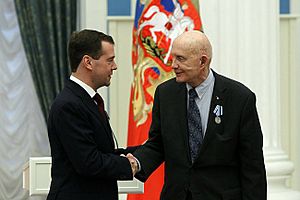
His military awards include the Air Force Distinguished Service Medal and the Distinguished Flying Cross. Other awards include the NASA Distinguished Service Medal and the NASA Exceptional Service Medal. He also received the Octave Chanute Award (1976) and the Golden Plate Award (1976). He was given the Gold Space Medal from the Fédération Aéronautique Internationale (FAI) in 1976.
In 2011, Stafford received the National Aeronautic Association Wright Brothers Memorial Trophy. He was also given the Air Force Association's Lifetime Achievement Award. He was chosen for the National Academy of Engineering in 2014. Stafford is a member of several Halls of Fame. These include the National Aviation Hall of Fame and the U.S. Astronaut Hall of Fame.
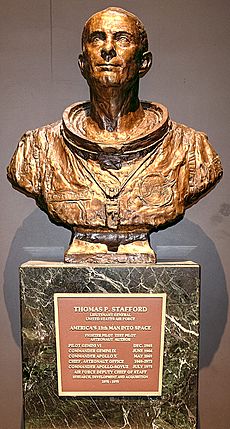
In his hometown of Weatherford, Oklahoma, a building at Southwestern Oklahoma State University is named after him. There is also the Thomas P. Stafford Airport and the Stafford Air & Space Museum. The Stafford Building at the Federal Aviation Administration (FAA) center in Oklahoma City is also named after him. In 2018, Stafford was even featured in a corn maze in Hydro, Oklahoma!
See also
 In Spanish: Thomas P. Stafford para niños
In Spanish: Thomas P. Stafford para niños


